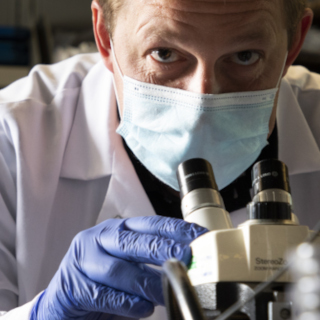Veterinary Verification and Consultation
Date Adopted: April 10, 2018
Last Review Date: January 11, 2021
I. Policy
The Office of Laboratory Animal Welfare (OLAW) issued a Guidance on Significant Changes to Animal Activities (NOT-OD-14-126) which was developed to support the use of performance standards and professional judgment to reduce the regulatory burden on the Institutional Animal Care and Use Committee (IACUC). The purpose of this policy is to enable the IACUC to authorize the Attending Veterinarian (AV) to make certain significant allowable changes (amendments) to pre-approved AUP’s through the process of Veterinary Verification and Consultation (VVC).
II. Significant Changes Allowable with VVC
The following specific significant changes (amendments) to an IACUC-reviewed and -approved protocol may be processed administratively with the VVC by the AV and without full committee (FCR) or designated member review (DMR).
A. Changes to anesthesia, analgesia, or sedation to referenced drugs and dosages
for a given species listed. Examples may include:
1. A change in dosage, route, frequency, or duration within acceptable
veterinary parameters.
2. Switching from one analgesic, anesthetic, or sedative agent to another.
B. Changes in the dosage, timing, or route of an experimental substance if the
change will not increase the potential for animal pain or distress.
C. Changes to experimental substances, including a change in test compound,
dose, or route of administration, as long as the changes does not result in a
change in study objectives or greater pain, distress, or degrees of invasiveness.
Note that the addition of a non-pharmaceutical grade drug or a change from a
pharmaceutical grade to a non-pharmaceutical grade drug requires additional
justification and will not be authorized under this mechanism.
D. Changes in euthanasia to any method approved in the current AVMA Guidelines for
the Euthanasia of Animals.
E. Changes in duration, frequency, type, or number of approved procedures
performed on an animal, as long as the change does not result in greater pain,
distress, or degree of invasiveness. The AV may use his/her discretion to authorize
minor procedural changes to previously IACUC-approved AUP’s providing, in the
judgment of the Attending Veterinarian, the change will not unduly impact animal
welfare (i.e., lessens or involves equivalent pain, acute or chronic stress, distress or
effects upon animal welfare) and is consistent with current standards of veterinary
practice or specifically addressed in IACUC policy. Common examples include:
1. Changes related to blood collection (e.g., frequency, volume, vessel access)
2. Revision of sample collection intervals or total samples collected
3. Substitution of one accepted biopsy method for another for tissue or DNA
analysis
4. Altering the duration or interval between procedures (e.g., lengthening an
imaging episode or the time between episodes)
5. Changing a method of identification
6. Altering behavioral testing methods, providing they do not involve
unrelieved pain or distress
7. Increases or enhancements in enrichment
8. Programs of post-anesthetic care that are enhanced above IACUC-approved
minimums
F. Changes in stock, strain, or genetic modification, unless the new stock, strain, or
modification results in abnormalities that require special support.
III. VVC Process at the University of Montana
A. All significant changes to an AUP must be submitted via the amendment process
to the IACUC for review.
B. The IACUC Coordinator and Attending Veterinarian will pre-review the submission
and determine if it meets criteria for VVC and to verify that compliance with the
VVC policy is appropriate for the animals in this circumstance. Consultation with
the AV will be documented by the IACUC Coordinator and the PI will receive
written confirmation that the change has been reviewed and approved.
C. A list of AUPs administratively reviewed and amended by VVC will be provided to
the IACUC at the next scheduled IACUC meeting. The AV may refer any VVC
request to the IACUC for review for any reason.
D. Significant changes that may not be handled administratively by VVC and must
undergo either full committee or designated member review include, but are not
limited to:
1. A change from non-survival to survival surgery
2. Any change resulting in greater pain, distress or degree of invasiveness
3. A change in housing or use of animals in a location that is not part of the
animal program overseen by the IACUC
4. A change in study objectives
5. A change in Principal Investigator
6. A change that impacts the safety of personnel
7. A change in the method of euthanasia not approved by the 2020 AVMA
Guidelines for the Euthanasia of Animals
8. Addition of a new procedure type
IV. UM-Related Policies and Guidance Documents
Guidance documents that are covered under this policy include the following:
A. Drug formularies are general guidance documents listing acceptable uses,
dosages, and routes of administration of a wide variety of drugs that may be
administered to animals. Drugs listed in the Veterinary Drug Handbook, 8th Edition
are covered under this policy.
B. The UM IACUC website has a list of approved anesthetics, analgesics and
sedatives that include drug regimens that investigators can refer to in their
protocols. The VVC process may be used to amend the dose, route,
concentration, volume, and/or duration of an approved anesthetic, analgesics, or
sedative.
C. The UM IACUC website has a list of approved blood collection volumes and
frequencies for the rat and mouse that investigators can refer to in their protocols.
The VVC process may be used to change the listed site of blood collection,
volume, or frequency of blood collection in an approved AUP.
D. The UM IACUC website has a chart of approved injection routes, maximum
volumes/ injection route, and needle sizes for various species. The VVC process
may be used to change the listed injection route, volume, or needle size for
injections in an approved AUP.
E. Should an investigator wish to use an anesthetic, analgesic, euthanasia agent or
sedation protocol that is not represented on the UM IACUC website, published
references must be submitted at the time of the request supporting the use of the
requested drug or drug combination in the species of interest.
